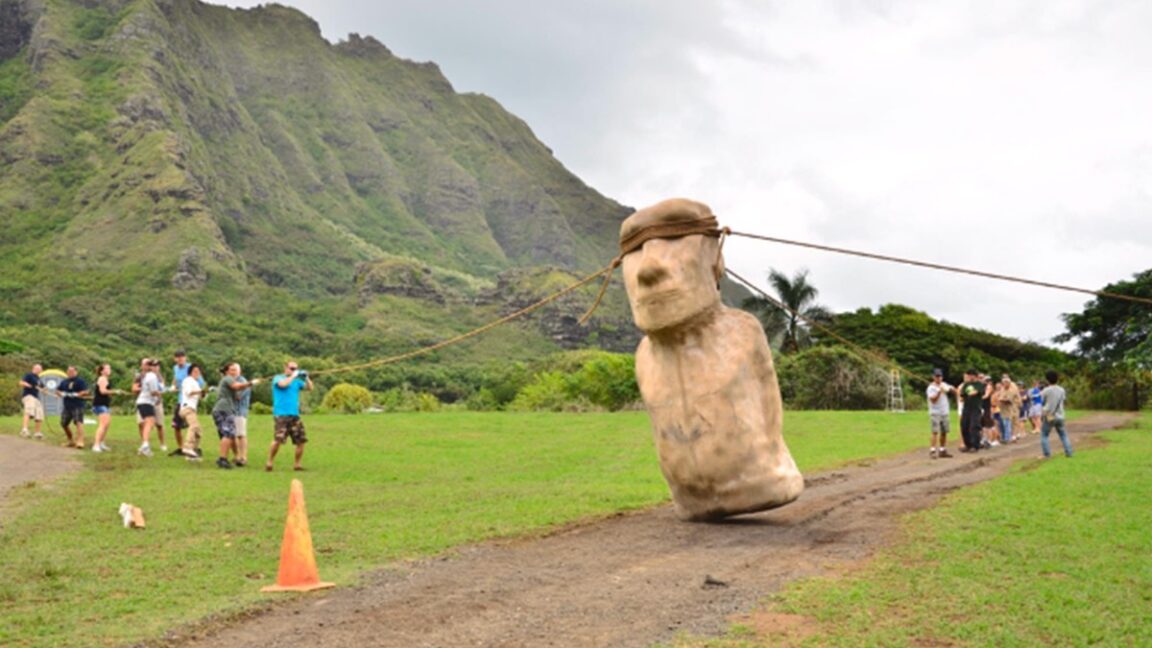Science
New Evidence Reveals How Easter Island Statues “Walked” to Platforms

Easter Island’s iconic moai statues, constructed approximately 800 years ago, have long intrigued researchers with their cultural significance and the engineering feats involved in their transport. A recent paper published in the Journal of Archaeological Science by archaeologist Carl Lipo and his colleagues introduces new experimental evidence supporting the hypothesis that these colossal figures were moved in a vertical position, allowing them to “walk” from quarries to their final placements on platforms called ahu.
For decades, scholars have theorized about how the moai, some weighing up to 92 tons, were transported across the remote island, measuring just 14 by 7 miles. Oral traditions among the Rapa Nui people reference the statues walking from their quarry to their positions, lending cultural weight to the idea. Lipo’s hypothesis, initially tested in 2012, proposed that a small team of workers could use ropes to create a lateral rocking motion, effectively making the statues walk.
In their groundbreaking 2012 experiment, Lipo and his colleague Terry Hunt demonstrated that a 10-foot, 5-ton moai could be moved a few hundred yards using just 18 people. Subsequent research has focused on the mechanics of transporting larger statues, including the placement of red hats, which can weigh up to 13 tons. Lipo’s team has also studied how the location of the moai correlates with fresh water sources, suggesting that the islanders strategically placed the statues for practical reasons.
New Findings and Experimental Approaches
Lipo revisited the walking hypothesis due to limitations in the original experiment, which was constrained by time and the filming schedule for a documentary. His latest work aims to delve deeper into the physics behind the transport method, establishing predictions about the number of participants and the speed of movement. The new trials involved a precisely scaled replica weighing 4.35 metric tons, maintaining the same proportions and mass distribution as original moai.
The recent experiments required a coordinated effort from 18 people, with four managing lateral ropes and ten on a rear rope. This teamwork allowed the statue to move 100 meters in just 40 minutes. Lipo noted that the method relies on basic pendulum dynamics, minimizing friction and enhancing movement efficiency. The researchers believe that such a system could allow the statues to be transported several kilometers over weeks, using modest crews of between 20 to 50 people, similar to the size of an extended family on the island.
Previous attempts to validate the walking hypothesis had not yielded widespread acceptance due to insufficient evidence. Lipo and Hunt argue that earlier experiments, including those by Czech archaeologist Pavel Pavel in the 1980s, used moai already modified for stability, rather than the road moai designed for movement. They assert that the original designs indicate intentional engineering for transport, which was later altered for ceremonial display.
Archaeological Insights on Moai Transport
Lipo and Hunt’s analysis extends to the moai’s roadways, which feature concave cross sections. This design would have posed challenges for horizontal transport but aided in the vertical rocking motion necessary for movement. The average slope of these ancient roadbeds is between 2–3 percent, and the researchers found that steeper gradients could be navigated through controlled stepping.
Their findings suggest that the distribution of moai along these roads indicates they were left behind due to mechanical failure, rather than being placed ceremonially. Lipo emphasizes the importance of falsifiable claims in archaeological interpretations, arguing that assumptions about ritualistic placements lack substantive evidence.
Despite facing criticism from peers, Lipo remains committed to using empirical data to build a comprehensive understanding of moai transport. He believes that linking experimental archaeology with physics can yield valuable insights into past practices, allowing researchers to explain the processes that shaped the present.
In conclusion, the ongoing exploration of how Easter Island’s moai were moved is not only a testament to the ingenuity of the Rapa Nui people but also a reflection of the evolving methodologies in archaeology. As Lipo and his team continue their research, they contribute to a growing body of evidence that challenges established narratives and enhances our understanding of this remote island’s remarkable history.
-

 Science2 months ago
Science2 months agoToyoake City Proposes Daily Two-Hour Smartphone Use Limit
-

 Health2 months ago
Health2 months agoB.C. Review Reveals Urgent Need for Rare-Disease Drug Reforms
-

 Top Stories2 months ago
Top Stories2 months agoPedestrian Fatally Injured in Esquimalt Collision on August 14
-

 Technology2 months ago
Technology2 months agoDark Adventure Game “Bye Sweet Carole” Set for October Release
-

 World2 months ago
World2 months agoJimmy Lai’s Defense Challenges Charges Under National Security Law
-

 Technology2 months ago
Technology2 months agoKonami Revives Iconic Metal Gear Solid Delta Ahead of Release
-

 Technology2 months ago
Technology2 months agoSnapmaker U1 Color 3D Printer Redefines Speed and Sustainability
-

 Technology2 months ago
Technology2 months agoAION Folding Knife: Redefining EDC Design with Premium Materials
-

 Technology2 months ago
Technology2 months agoSolve Today’s Wordle Challenge: Hints and Answer for August 19
-

 Business2 months ago
Business2 months agoGordon Murray Automotive Unveils S1 LM and Le Mans GTR at Monterey
-

 Lifestyle2 months ago
Lifestyle2 months agoVictoria’s Pop-Up Shop Shines Light on B.C.’s Wolf Cull
-

 Technology2 months ago
Technology2 months agoApple Expands Self-Service Repair Program to Canada









